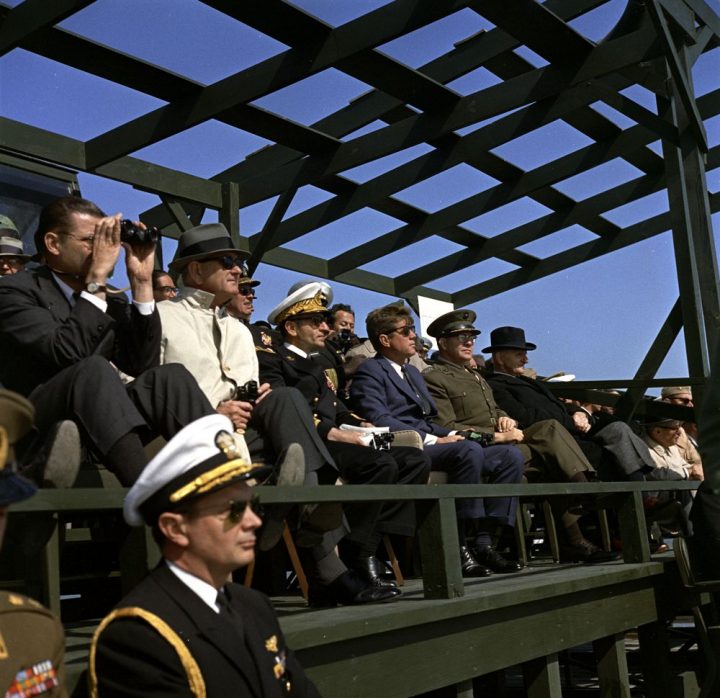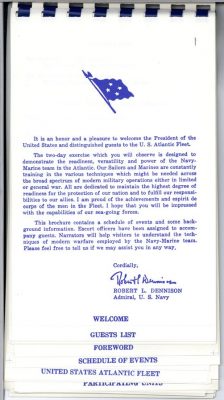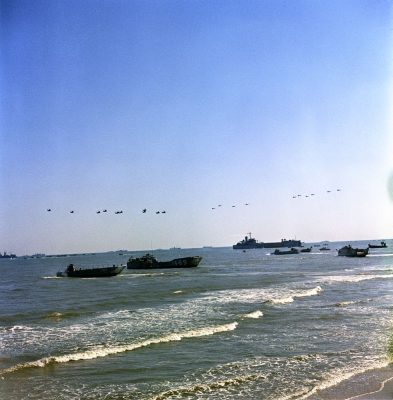
EASTERN NORTH CAROLINA — It was a beautiful spring afternoon in 1962, April 14, to be exact — nearly 55 years ago today.
The weather forecast for the weekend was “not very favorable. Rain and thunderstorms are expected,” according to an article printed Friday, April 13, 1962, in the Carteret County News-Times.
Supporter Spotlight
However, photos from the collection “Visit to the Atlantic Fleet: President Kennedy views Marine Corps exercises at Bogue Field and Onslow Beach, Camp Lejeune, North Carolina, 2:11PM,” showed that the forecast was clear for the arrival of President John F. Kennedy. There was not a cloud in the crisp blue sky above Marine Corps Air Station Cherry Point, where the News-Times reported that a 10-minute departure ceremony was wrapping up the president’s two-day official visit to see the U.S Atlantic Fleet perform sea and air power demonstrations.
These photographs can be found on The John F. Kennedy Presidential Library and Museum website and were taken when Kennedy, along with an entourage of ambassadors, high-ranking military, national press and elected officials, visited the military bases in the Norfolk area and eastern North Carolina between April 13-14, 1962, to observe the fleet.
Now known as the U.S. Fleet Forces Command, the fleet is comprised of Navy and Marines officers responsible for operations in and around the Atlantic Ocean.

In the commemorative booklet distributed in honor of Kennedy’s visit to the Atlantic Fleet, its commander, Navy Adm. Robert L. Dennison wrote that during the visit, President Kennedy and distinguished guests would observe a two-day exercise “designed to demonstrate the readiness, versatility and power of the Navy-Marine team in the Atlantic.”
“Our sailors and Marines are constantly training in the various techniques which might be needed across the broad spectrum of modern military operations either in limited or general war,” he said.
Supporter Spotlight
Also noted in the booklet is the impressive guest list that included several dozen ambassadors from all over the world, including: Peru; Japan; Australia; Libya; Chile; Thailand; Ghana; Republic of Togo; Republic of Senegal; Venezuela; Republic of Congo; Republic of Guinea; New Zealand; Korea; Liberia; Costa Rica; Republic of Gabon; the Philippines; and United Arab Republic. Also visiting were military officers, U.S. senators and representatives, White House staff and media.
You glean a brief bit of history about naval warfare from the commemorative booklet, but more importantly, that the exercises were to demonstrate the effectiveness and versatility of the Navy-Marine team in the Atlantic. Demonstrations included creating a sonic boom; loft bombing, an aerial attack at low altitude with a sudden climb just as the bombs are released, also demonstrated in formation; bullpup air-to-ground missile capability; napalm bombing; rockets; sidewinder missiles; air fueling; glide bombing, or a less extreme variation of dive bombing; formation flying; and a mass flyby.
The bulk of the schedule the afternoon of April 13 and the morning of April 14 was filled with visits to military installations in the Hampton Roads area. The party had the opportunity to visit aircraft carriers, the USS Forrestal, USS Enterprise and the command ship, USS Northampton, and review the fleet of vessels while at U.S. Naval Station in Norfolk, Virginia.
According to the News-Times, after his journey on the USS Enterprise from Norfolk on April 14, 1962, to Onslow Beach, Kennedy met there His Imperial Majesty Mohammad Reza Shah Pahlavi, the Shah of Iran, to view an amphibious landing staged by the Marine Corps with 10,000 to 12,000 Marines. The Shah was responsible for a movement in Iran in the 1960s and ’70s with the goal of turning it into a global power. The Friday edition of the News-Times that week noted the Shah had arrived on Wednesday in Washington, D.C.
According to the News-Times report, the two leaders and their entourage then flew north by helicopter to Bogue Field off Highway 24 and on the north shore of Bogue Sound in western Carteret County. Bogue Field, a 573-acre auxiliary airfield built with three 4,000-foot runways in 1942, was used mainly for dive-bomb squadron training during World War II, with nearby islands in the sound serving as targets. Bogue Field was decommissioned after the war and made an outlying field for nearby Marine Corps Air Station Cherry Point.
The president and his entourage were here to observe a demonstration of the Marine Corps’ first Short Airfield for Tactical Support, or SATS, a prefabricated system installed at Bogue Field in 1958 that included a catapult and arresting system for jet take-offs and landings on a short runway, much like systems used at sea on aircraft carriers.
There’s only one active runway now at Bogue Field, but carrier landing practice is still a big part of operations here. To that end, the outline of an amphibious assault ship’s deck is painted on the asphalt. Short take-offs and landings are also a focus for the AV-8B Harrier “jump jet” pilots that practice at Bogue Field.
Back on April 17, 1962, the News-Times reported that an estimated 6,000 to 8,000 people had waited for a glimpse of Kennedy as he arrived at Cherry Point. It was a tumultuous year for the presidency.
When elected in November 1960, Cold War tensions between the United States and Soviet Union had been brewing for 15 years, since the end of World War II. Tensions escalated a year earlier, in April 1961, when Kennedy oversaw the failed Bay of Pigs Invasion in Cuba, an attempted coup that instead further solidified both the Fidel Castro’s power and Cuba’s relationship with the Soviet Union. The debacle also led to a secret deal between Castro and the Soviet Premier Nikita Khrushchev that had yet to unfold as Kennedy toured the Carolina coast.
A few months later, in October 1962, the Atlantic Fleet and Adm. Dennison would again be in Kennedy’s sights.
U.S. intelligence officials learned that Khrushchev had been deploying ballistic missiles to Cuba over the summer of 1962. The Atlantic Fleet was called to action in the ensuing Cuban Missile Crisis, when many say the U.S. and the Soviet Union reached the brink of global nuclear war.

Naval forces under the U.S. Atlantic Command, headed by Adm. Dennison, and allies intercepted Soviet submarines and merchant ships en route to Cuba, establishing a “quarantine” – rather than the more warlike “blockade” of the island. Khrushchev nonetheless considered the action an “act of aggression,” but agreements were eventually reached.
According to the Naval History and Heritage command, being faced with the full brunt of the U.S. and allied naval and military forces, Khrushchev was forced to “peacefully disengage his nation from this most serious of Cold War confrontations.”
Amid the Cold War tensions in the early 1960s, eastern North Carolina remained fairly removed. The area, which was primarily dotted with fishing villages for centuries, was, however, changing into what we know today. Bogue Banks was developing into a vacation destination, and the once-thriving commercial fishing industry based on the working waterfronts in Morehead City, Beaufort and Down East was slowly being edged out for recreational fishing. Now you’ll find the docks home to high-end sportfishing boats rather than the work boats that used to tie up for the night.
By all indications of the headlines of the News-Times during his visit, the Crystal Coast truly was a quiet place. On page 1A of the Friday, April 13, 1962, edition, sharing the headlines with “President to View War Games, Visit Bogue Field,” were the following headlines: “$3,500 in Silver Dollars Will Go To Guard Unit,” regarding a donation to the National Guard in Morehead City; “Woman Injured In Car Accident,” in which the driver was “shaken up” considerably; and “Norris Hill Caught It, But Didn’t Know What It Was,” about a missing Egyptian goose that belonged to a Beaufort resident.
The Tuesday, April 17, 1962, edition of the News-Times featured a stand-alone photo of Kennedy walking toward the viewing stands at Bogue Field, flanked by military officials. That photo was political in nature, as Kennedy sought to affirm in a midterm elections year his campaign pledge of continued American leadership and military might, along with the newspaper’s anchor stories that day: “61 Sign Up for May 26 Primary” and “Candidate Faces Fraud Charges on Tax Returns.” The paper also had its share of more mundane local news, including “Beach to Get Street Markers,” detailing when Atlantic Beach would be getting street signs.
While Kennedy’s little-known visit to the Hampton Roads area of Virginia and eastern North Carolina didn’t garner much attention on the local or national scale, the U.S. Atlantic Fleet proved to be an important part of history and a vital part of the effort in keeping nuclear arms at bay during the Cold War.








